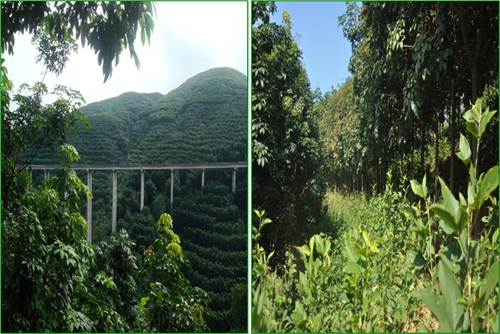Many natural forests have been converted to monoculture rubber (Hevea brasiliensis) plantations in Xishuangbanna, which brought negative impacts on biodiversity of the region. The rubber agroforestry system, which combines agricultural and forestry technologies to create a more diverse, productive, healthy, and sustainable land-use system, is regarded as the best way to improve the sustainability of rubber monocultures. However, few reports have examined water use in such systems.
Prof. LIU Wenjie and his team of Xishuangbanna Tropical Botanical Garden (XTBG) conducted a study to test whether interplanting with Flemingia macrophylla, a leguminous, perennial, leafy shrub, could facilitate water utilization of rubber trees. They investigated the interspecific and intraspecific differences and variation in Hevea-Flemingia agroforestry systems among seasons in order to realize the beneficial effects of Flemingia macrophylla on rubber plantation with respect to water use.
The researchers measured the stable isotope ratios (δD and δ18O) of water in soil, rain, and plant tissue samples to quantitatively distinguish plant water sources. They also measured leaf δ13C and the soil water content over the course of a rainy/dry season cycle (2013–2014) to compare the interspecific and intraspecific water use efficiency and moisture conservation ability of the system, respectively. To characterize the ecophysiological properties of the plants, they measured the leaf C and N concentrations and shoot water potential.
The study found that the Hevea-Flemingia agroforestry systems maintained much more soil water than rubber monoculture systems. The agroforestry systems reduced soil moisture evaporation via undergrowth coverage and can thus greatly conserved soil water and helped maintain local microclimatic stability, despite in face of the adverse factors. To avoid intense competition with the interplanted species for water, rubber trees expanded their water absorption zone to the deep soil layer. Interplanting could improve the water use efficiency and productivity of rubber tree via species interaction. The rubber plants and the interplanted Flemingia macrophylla could extract water from different source. The results suggested that planted with Flemingia macrophylla had more beneficial effects than single cropping.
The study entitled “Below-ground interspecific competition for water in a rubber agroforestry system may enhance water utilization in plants” has been published in Scientific Reports.
Contact
LIU Wenjie, Ph.D Principal Investigator
Key Laboratory of Tropical Forest Ecology, Xishuangbanna Tropical Botanical Garden, Chinese Academy of Sciences, Mengla, Yunnan 666303, China
E-mail: lwj@xtbg.org.cn

Monoculture rubber plantation (L) and Hevea-Flemingia agroforestry system (R) in Xishuangbanna (Image by WU Junen) |

